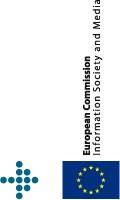The REACTION
project has investigated the clinical workflows in a general
practice and in a hospital to close the gap between present
practice and the potential of the REACTION platform. The results
have been used to develop a set of initial requirements for
the platform.
How do feel your diabetes management is currently
being delivered? What problems are you facing? What do you
think would help? Do you see any value in knowing what value
your blood sugar is all the time?
These were some of the questions asked to
diabetic patients participating in a workshop on diabetes
management that took place earlier this year at the UK based
general practice, Chorleywood Health Centre. Supplemented
by a workshop at the University of Graz in Austria, the two
sessions were held with the aim of identifying existing clinical
routines in diabetes management outside and inside the hospital
and to determine the requirements of patients, informal carers
and healthcare professionals. The results show a need to consider
all the co-morbidities existing alongside diabetes when providing
treatment and to develop a platform which supports the decision
making process in a way that makes monitoring of blood glucose
levels easy, efficient and less error-prone.
The co-existence of diseases
For diabetic patients in contact with the
healthcare system outside the hospital, the goal for the REACTION
service platform is to help the patients to better control
their diabetes by giving them monitoring devices which continuously
monitor the blood sugar level and give feedback on treatment.
One of the most significant outcomes of the
five interviews conducted in Chorleywood Health Centre, a
medium sized general practice in North-West London and partner
in REACTION, was the fact that even if the participants were
all at different stages of the disease, with different types
of the disease, they had one thing in common. They all had
complications and co-morbidities existing alongside their
diabetes. Shona Thomson who is a Practice Nurse at Chorleywood
Health Centre explains:
“Diabetes impacts on all systems of the body:
Eyes, kidneys, cardiovascular system, endocrine and nervous
system. Often eye disease is present at diagnosis and some
men have been screened after presenting with erectile dysfunction
and found to be diabetic. This means that patients with diabetes
will rarely just have diabetes apart from the very young Type
1 insulin-dependent patients under 18.”
Since co-morbidities are present in practically
every diabetic patient, clinicians need to look not only at
blood sugar control but at the entire range of co-morbidities
in order to give the best possible care.
 “The
co-morbidities associated with diabetes are serious. If patients
with diabetes do not control their blood sugar well, they
can develop renal disease, neuropathy, diabetic retinopathy
and atherosclerosis, which is caused by narrowing of the arteries.
If not looked for or monitored, this can result in heart attacks,
strokes, gangrene in lower limbs, kidney failure and blindness.
These are serious conditions often leading to premature death
and disability which is why it is so important to ensure that
all people with diabetes have regular check-ups, to ensure
blood sugar levels are maintained within certain limits and
ensure early detection of these possible complications, to
avoid the poor outcomes associated with them. This will often
entail lifestyle changes such as weight loss, more physical
activity, no smoking and changes in diet including alcohol
intake. There is good evidence that controlling blood sugar
levels will reduce the incidence of these complications,”
says Shona Thomson. “The
co-morbidities associated with diabetes are serious. If patients
with diabetes do not control their blood sugar well, they
can develop renal disease, neuropathy, diabetic retinopathy
and atherosclerosis, which is caused by narrowing of the arteries.
If not looked for or monitored, this can result in heart attacks,
strokes, gangrene in lower limbs, kidney failure and blindness.
These are serious conditions often leading to premature death
and disability which is why it is so important to ensure that
all people with diabetes have regular check-ups, to ensure
blood sugar levels are maintained within certain limits and
ensure early detection of these possible complications, to
avoid the poor outcomes associated with them. This will often
entail lifestyle changes such as weight loss, more physical
activity, no smoking and changes in diet including alcohol
intake. There is good evidence that controlling blood sugar
levels will reduce the incidence of these complications,”
says Shona Thomson.
Monitoring can have a preventive
effect
The REACTION platform will provide tools
that support lifestyle changes and assist the patient in keeping
the blood sugar level under control. For this purpose, REACTION
aims to provide patients with a monitoring device such as
a plaster with sensors that continuously monitor the blood
sugar level of the patient and give feedback.
In general the patients were positive towards
monitoring and feedback as a help to support lifestyle changes.
One of the interviewed patients said that monitoring could
actually help him understand how his blood sugar reacted when
eating or doing exercise. Shona Thomson also believes in the
preventive effect.
“I think that the platform would help the
newly diagnosed understand which foods increase their blood
sugar. If they keep a food diary, they can correlate this
with the general trends. It will also help them to see how
their medication helps to lower their levels so it may encourage
them to participate more in their own care. The feedback the
platform can offer will also be really useful to clinicians;
it will show us when patients may need a bit more help and
support.”
Diabetes management in hospitals
To approach diabetes management in hospitals,
another workshop was held at the Medical University of Graz
(MUG) in Austria, another partner in REACTION. MUG is a young
university hospital offering a 20-bed in-hospital general
ward with special expertise in the treatment of diabetes and
associated metabolic disorders.
Since it is the nurse or the physician who
controls the blood sugar levels in those hospitalised patients
who are not able to control their blood sugar by him- or herself,
the aim for the REACTION platform is to support the staff
in improving glycaemic control of admitted patients using
continuous blood glucose monitoring and therapy feedback.
Patients do not always know that
they have diabetes
Unlike Chorleywood, most of the patients
in Graz are not admitted because of diabetes or risk of diabetes
but because of other diseases.
“Some patients do not even know that they
have diabetes and others develop hyperglycaemia, also called
stress-induced diabetes, caused by their primary illness.
Unfortunately, patients with diabetes are more likely to suffer
from other diseases hence the number of patients with diabetes
in the hospital is large,” explains Dr. Lukas Schaupp, a Senior
Scientist at MUG.
Keep glucose levels within certain
limits
In the hospital the aim is to cure the primary
condition that caused the hospitalisation and to keep other
complications within certain limits. However, there is a special
interest in preventing hyperglycaemia since it can have considerable
consequences for the health of the patient.
“Even if there is no clear evidence available,
it is very likely that hyperglycaemia is not beneficial for
the patient who can develop more complications, some of which
can be life threatening. Our hypothesis is that keeping the
glucose levels within certain limits is beneficial for the
patients. However, this is labour-intensive and there is a
risk of inducing hypoglycaemia in the patient, a state which
is life threatening,” says Lukas Schaupp.
The system must support the decision
on treatment
Since it takes a considerable amount of effort
to control the blood sugar levels because of the frequent
bedside glucose monitoring and decision making, it is crucial
that information is readily available and adaptable and that
the system streamlines the workflow processes and supports
the decision on treatment.
“The relevant information must be available
for the physician in a way that can be easily customised.
The physician needs a visualisation of the relevant parameters,
alarms/reminders for different tasks and finally decision
support for dosing. Furthermore, the system should communicate
with the hospital information system, with the laboratory
system and also with the health record forms of the patient.
Having the information available in an electronic form, it
can be used simultaneously by different services, enabling
also automatic processing of different tasks. This will mean
less workload, fewer errors and easy archiving,” says Lukas
Schaupp.
The system requirements are currently in
the process of being implemented in REACTION and will be tested
and developed during the project. For Lukas Schaupp, the potential
of the project lies in proving that glycaemic control makes
a positive difference and in applying the platform to other
healthcare systems.
“Once the system is in place, it will be
possible to conduct clinical trials to prove that glycaemic
control is beneficial for the patients. In addition, the system
which is going to be built for glycaemic management can be
expanded to further applications, hence acting as an initial
step towards a broader use,” concludes Lukas Schaupp.
/lbr/
to
the top  |


 We
are very pleased to present this first issue of the REACTION
newsletter. The REACTION project is committed to improve the
daily life of diabetes patients across Europe with the aid
of world class Information and Communication Technology (ICT).
We are developing an integrated ICT platform that will improve
long term management of diabetes based on wearable, continuous
blood glucose monitoring sensors and automated closed-loop
delivery of insulin.
We
are very pleased to present this first issue of the REACTION
newsletter. The REACTION project is committed to improve the
daily life of diabetes patients across Europe with the aid
of world class Information and Communication Technology (ICT).
We are developing an integrated ICT platform that will improve
long term management of diabetes based on wearable, continuous
blood glucose monitoring sensors and automated closed-loop
delivery of insulin.
 Villads
has an insulin pump. A typical day is quite similar to before
the diabetes, apart from the blood glucose monitoring and
the weighing of some of Villads’ food. We/Villads himself
measure the blood glucose seven times on an average day: morning,
before lunch, when after-school care starts, in the afternoon,
before dinner, when Villads goes to bed and before we go to
bed.
Villads
has an insulin pump. A typical day is quite similar to before
the diabetes, apart from the blood glucose monitoring and
the weighing of some of Villads’ food. We/Villads himself
measure the blood glucose seven times on an average day: morning,
before lunch, when after-school care starts, in the afternoon,
before dinner, when Villads goes to bed and before we go to
bed.  “The
co-morbidities associated with diabetes are serious. If patients
with diabetes do not control their blood sugar well, they
can develop renal disease, neuropathy, diabetic retinopathy
and atherosclerosis, which is caused by narrowing of the arteries.
If not looked for or monitored, this can result in heart attacks,
strokes, gangrene in lower limbs, kidney failure and blindness.
These are serious conditions often leading to premature death
and disability which is why it is so important to ensure that
all people with diabetes have regular check-ups, to ensure
blood sugar levels are maintained within certain limits and
ensure early detection of these possible complications, to
avoid the poor outcomes associated with them. This will often
entail lifestyle changes such as weight loss, more physical
activity, no smoking and changes in diet including alcohol
intake. There is good evidence that controlling blood sugar
levels will reduce the incidence of these complications,”
says Shona Thomson.
“The
co-morbidities associated with diabetes are serious. If patients
with diabetes do not control their blood sugar well, they
can develop renal disease, neuropathy, diabetic retinopathy
and atherosclerosis, which is caused by narrowing of the arteries.
If not looked for or monitored, this can result in heart attacks,
strokes, gangrene in lower limbs, kidney failure and blindness.
These are serious conditions often leading to premature death
and disability which is why it is so important to ensure that
all people with diabetes have regular check-ups, to ensure
blood sugar levels are maintained within certain limits and
ensure early detection of these possible complications, to
avoid the poor outcomes associated with them. This will often
entail lifestyle changes such as weight loss, more physical
activity, no smoking and changes in diet including alcohol
intake. There is good evidence that controlling blood sugar
levels will reduce the incidence of these complications,”
says Shona Thomson.

